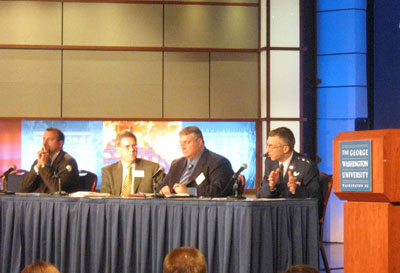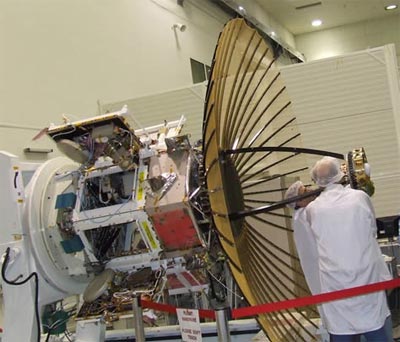Space policy 101: military space 2009<< page 1: chasing the intelligence space dragon National security space programsMajor General William McCasland, Director of Space Acquisition in the Office of the Under Secretary of the Air Force, was the first speaker for a panel on national security space programs and provided a status report on the Air Force’s space programs, briefly mentioning the traditional military space areas of missile warning, satellite communications, navigation, meteorology, and space launch, as well as the newcomer, operationally responsive space. McCasland said that now that the Space Based Infrared System (SBIRS) was nearing launch, the Air Force was “laying the groundwork for the evolution of this technology.” According to McCasland, the Air Force had benefited from NASA investment in large focal plane infrared sensors and was seeking to move beyond SBIRS to the next step in infrared missile warning.
McCasland also said that the Air Force had started launching the Wideband Global Satcom satellites and was considering how to evolve it now that the TSAT communications satellite system had been canceled. He said that satellite communications is about 25% of the Air Force’s investment in space. On the GPS program, McCasland said that the Air Force had come to realize that the Master Control Station (MCS) was vital to the success of GPS. Previously the Air Force had purchased the MCS as an afterthought to the satellite procurement and as a result did not get the contractor’s “A-team” or the best system. The Air Force has now made the MCS a separate procurement. McCasland next addressed the Air Force’s meteorological satellite program. The Air Force has three DMSP weather satellites left. One is scheduled for launch and the service is holding the last two on the ground until they determine that they are needed. Meanwhile, the Air Force is trying to define the next step for the NPOESS system that is supposed to eventually replace DMSP. He said that although there has been talk about “divorcing” the military and civilian systems, he did not know if that was likely to happen. Another area that McCasland addressed was Operationally Responsive Space (ORS). He said that they are now “on-contract” with the first “real ORS platform”—i.e. a satellite intended to serve operational needs rather than a technology test spacecraft. The payload will be an infrared imager developed from a U-2 aircraft payload. Finally, McCasland discussed space launch. He said that the military had now achieved 61 successful launches in a row, with 23 successful EELV launches in a row. This was the result of careful attention to quality and mission assurance. “There are probably about $2–4 billion delivered to orbit rather than dumped in the ocean,” he added. General McCasland was followed by Kevin O’Connell, the president of Innovative Analytics and Training, who said that he is currently finishing a historical study of the NRO. O’Connell said that over the years there have been many studies about how to align policies and budgets. He listed what he considers to be five important areas of alignment:
O’Connell said that people are constantly surprised when new international players enter the space arena. Most recently the Nigerians, Iranians, and Algerians have become space powers, which came as a surprise to some in the military and intelligence space communities. He also mentioned a recent Wall Street Journal article about graduate students looking at North Korea using tools like Google Earth and commercial remote sensing imagery. He said that the intelligence community “anticipated this more transparent world, but we did not really take advantage of it,” and they’re still not taking advantage of it.
The next speaker on the panel was Bob DeGrasse, a staffer on the House Armed Services Committee. DeGrasse said that Congress has played a role in making it difficult for the military and intelligence communities to operate. He noted that jurisdiction is split between the armed services and intelligence committees in Congress. He said that Congress cannot organize itself, and so it is no wonder that they cannot organize the intelligence community.
DeGrasse noted that in recent years space situational awareness received a lot of attention and he believes it has made progress. The military created both a space protection strategy and a space protection program. At the same time, he has been disappointed in the limitations of the current organizations and systems and referred to his visit to the Air Force organization responsible for tracking space debris where, in an age of supercomputers, it seemed like people were using grease pencils to make their calculations. DeGrasse said that the military has an ability to watch a small number of national security payloads to prevent collisions, but he would like to see that improve. Regarding space acquisition, DeGrasse said that the Executive Branch had finally killed the TSAT communications satellite, which Congress had been urging them to do for years. Unfortunately, he said, the DoD killed the system at exactly the time that the price of the Advanced EHF satellite program that could replace it increased dramatically. Josh Hartman, Director of the Space and Intelligence Capabilities Office of the Department of Defense was the next to speak. Hartman said that he is constantly asked whether the DoD needs a “space czar” to fix the acquisition mess. He said that although this would be helpful, it would still not solve all of their problems. In Hartman’s view, one of the problems facing military space is a lack of clear accountability. It is easy to say who runs the civil space program—NASA—but it is not clear who runs the military program. Is it someone in the Air Force? The NRO? The Office of the Secretary of Defense? The Director of National Intelligence? This makes it difficult for other agencies to coordinate with the military. He said that if NOAA has a question about a reconnaissance capability, they have to go to both the National Reconnaissance Office and the National Geospatial-Intelligence Agency to get an answer. Hartman said that there is no space “domain expertise” at the senior levels of the Office of the Secretary of Defense. There are experts on ground, air, and sea warfare at the OSD level, but there are no experts on space at the highest levels. The result is that “the discussion often devolves to the level of budget” rather than what can and needs to be done. Hartman expressed similar views to DeGrasse. Although the early 2007 Chinese ASAT test should have been a wakeup call, “I think that we have failed to move as fast and as far as we should in two and a half years,” Hartman said. He said that he thought that some recent efforts in several different areas set them on the correct path, but “the national security community has to clean its house before they invite the neighbors over.” He listed several areas that were in flux and required additional attention:
Hartman said that the military was having an internal debate about the value of Operationally Responsive Space. Some inside the DoD want to see it prove itself. The money is there to develop the first operational payload and one of the things that people will be looking at is how quickly they can develop the ORS-1 satellite. Both Major General McCasland and Hartman seemed to indicate that Operationally Responsive Space, despite finally getting off the ground, is in store for major bureaucratic challenges. Neither seemed optimistic—or enthusiastic—about its prospects. Although ORS proponents have long claimed that they were fighting a recalcitrant bureaucracy, McCasland and Hartman didn’t give them any reason to hope that the opposition would fade away. ORS advocates have made a lot of claims over the years, and have now reached the point where they have to demonstrate that those claims are valid. If they don’t do so quickly, their efforts may finally be snuffed out. Military space, quo vadis?Although the discussions ranged across many subjects, and many of the speakers acknowledged that military space, particularly acquisition, has experienced recent upheaval and significant cost overruns, schedule slippages, and cancellations, one subject that did not receive much attention was the issue of how to improve the overall system. As one would expect, many of the speakers could describe the problems, but not the solutions. One subject that has been discussed by military space leaders—but did not really come up during the relevant talks at the symposium—was the need to rebuild the military space program’s systems engineering expertise and procurement oversight. Unfortunately, for every step the military space community takes forward, it also seems to take a step back. Only a week after Al Munson spoke positively of the intelligence community’s decision to choose to upgrade an existing electro optical reconnaissance satellite system rather than pursue a radical new approach, Senator Diane Feinstein, chair of the Senate Select Committee on Intelligence expressed “extraordinarily serious concern” over the decision. Feinstein also sits on the Senate Appropriations subcommittee, and can clearly assert authority over the acquisition of this capability. A major fight is brewing over yet another program in this domain. Home |
|

